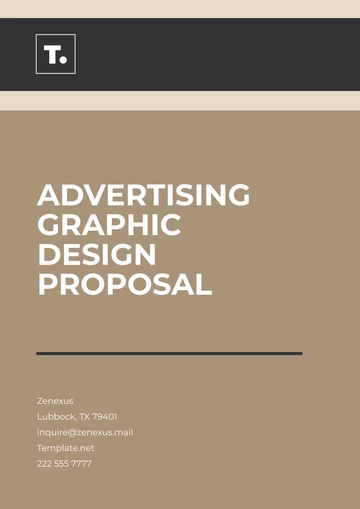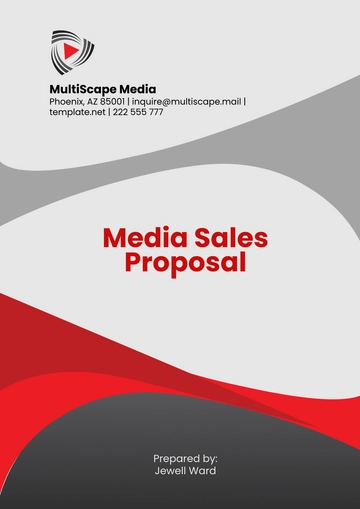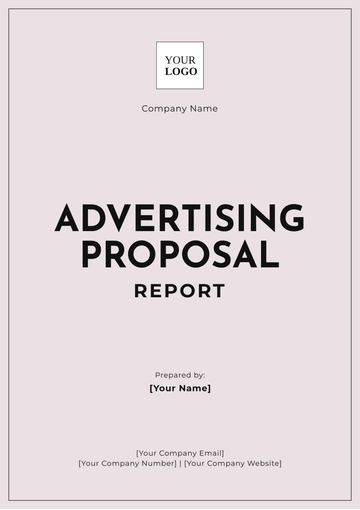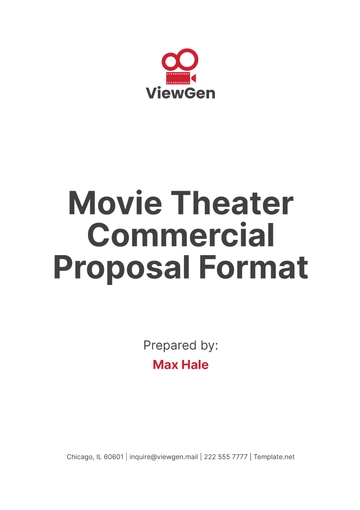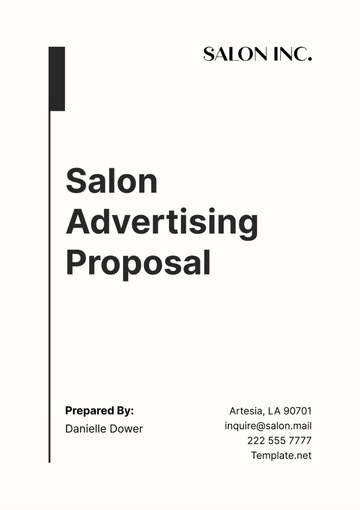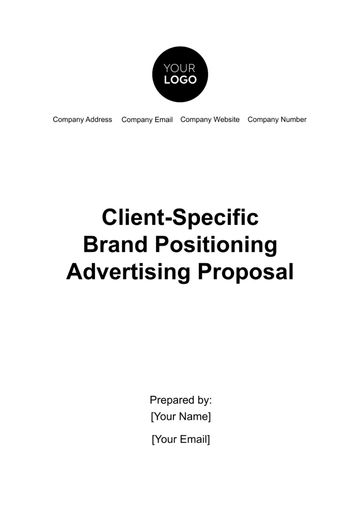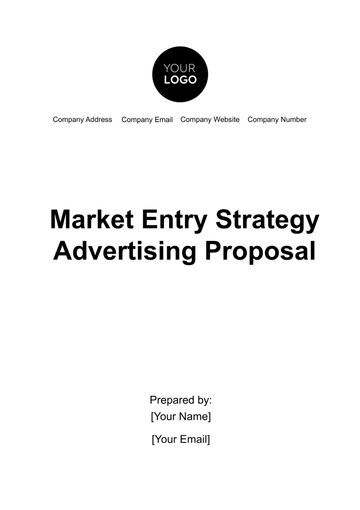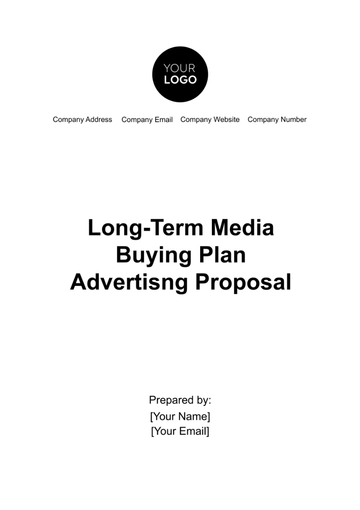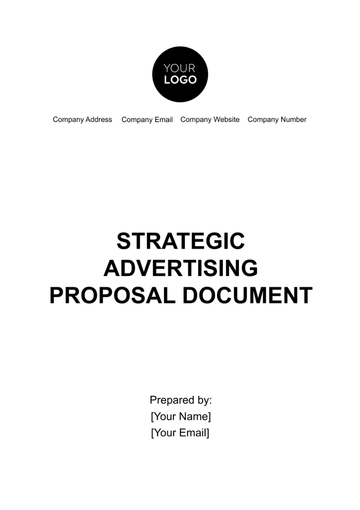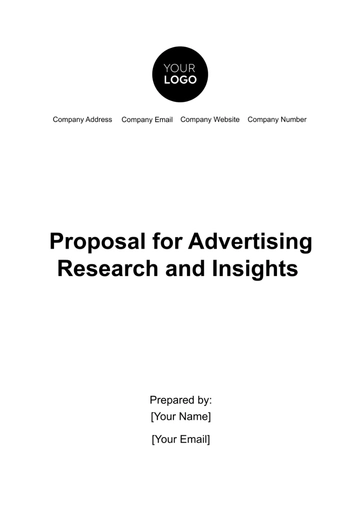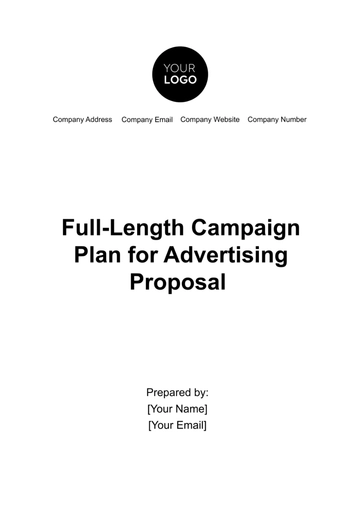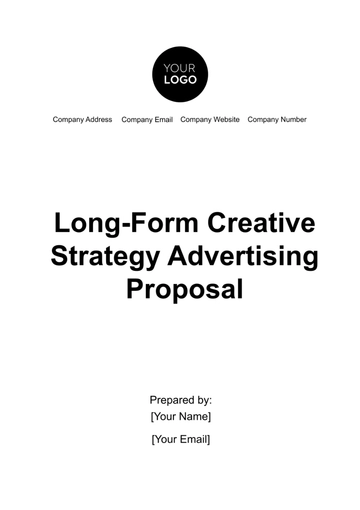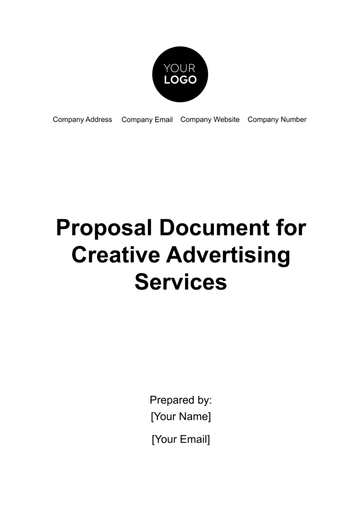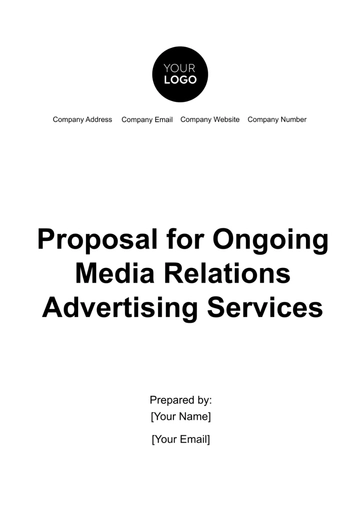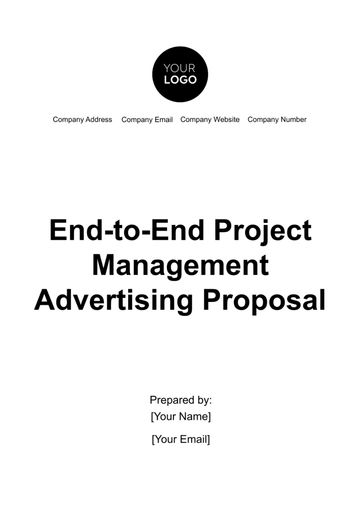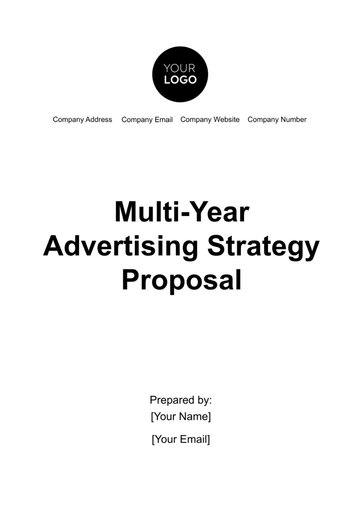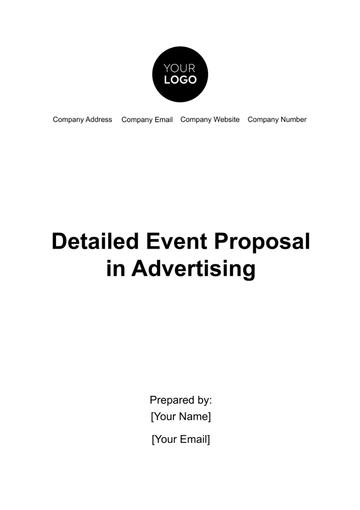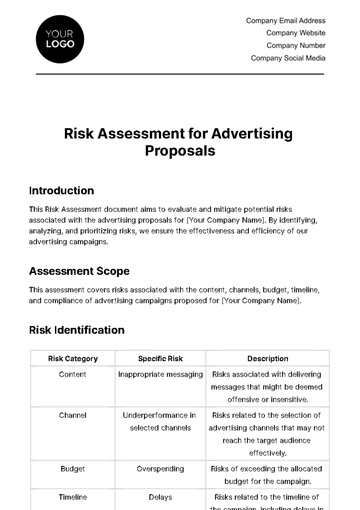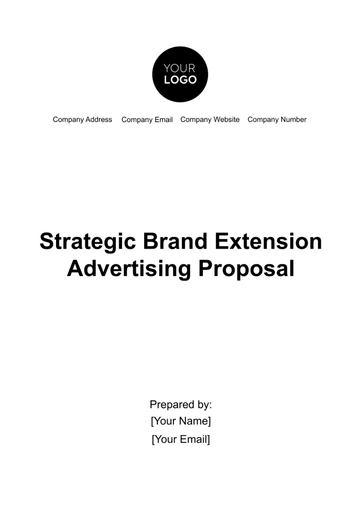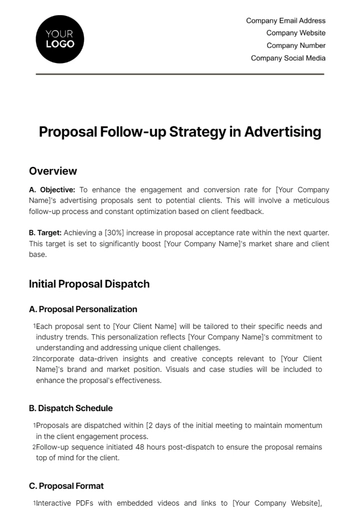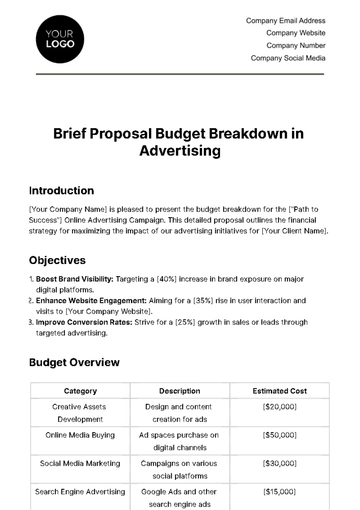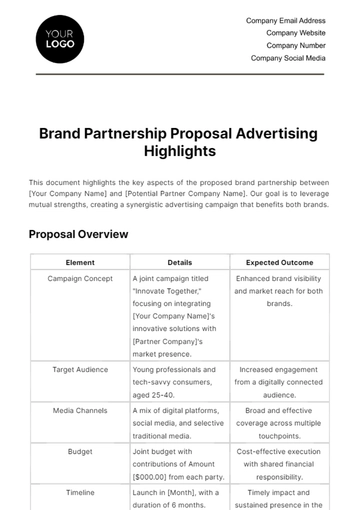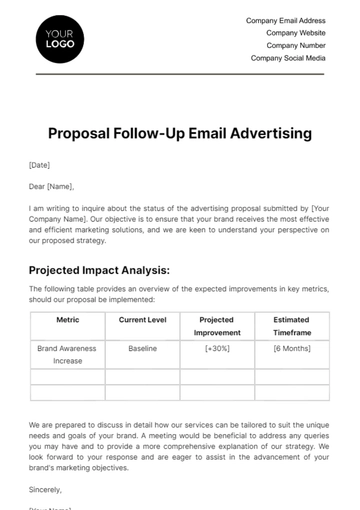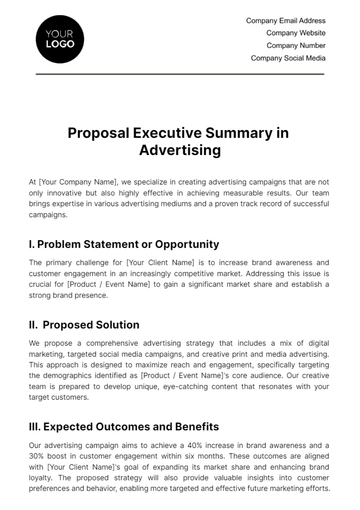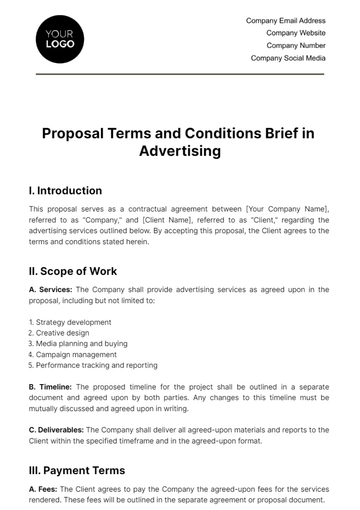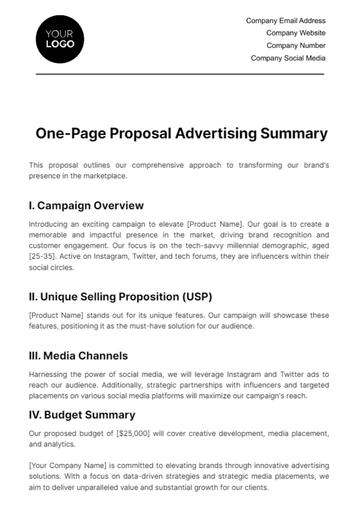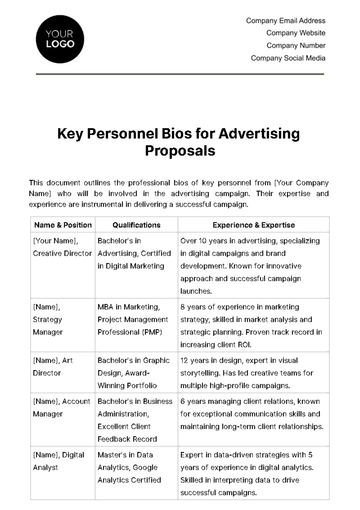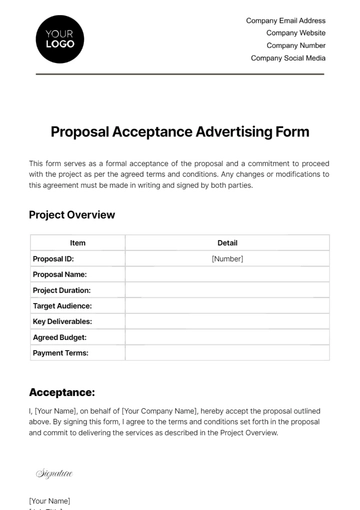Free Long-Form Creative Strategy Advertising Proposal
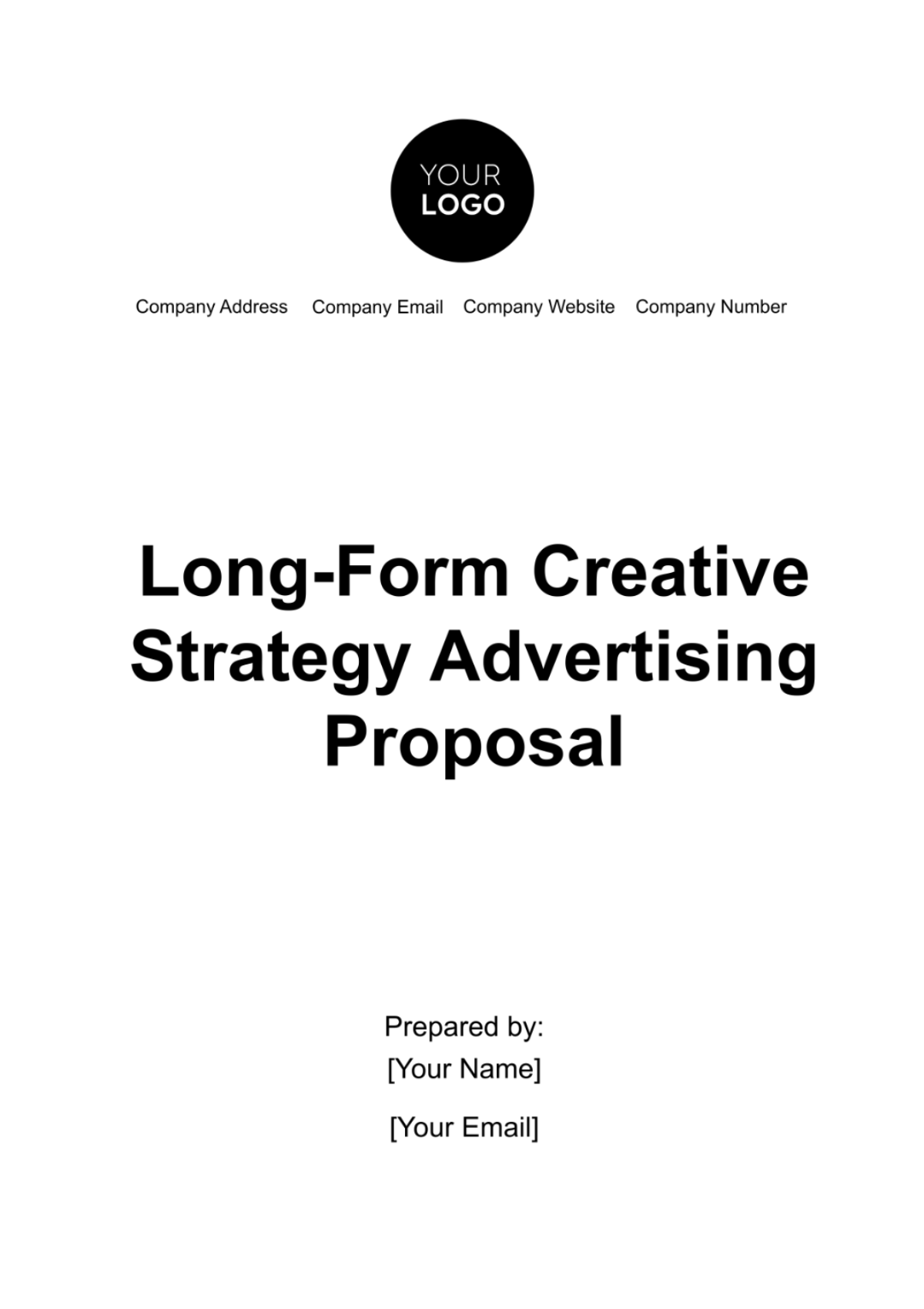
Executive Summary
In this proposal, [Your Company Name] presents a comprehensive creative strategy designed to elevate the presence and impact of [Client's Brand] in the highly competitive market. With our expertise in advertising and a keen understanding of your brand's objectives, we are confident in our ability to deliver exceptional results.
A. Objective: Our primary goal is to position [Client's Brand] as a market leader in the tech industry, increasing brand recognition and driving a 20% growth in sales within the next year.
B. Unique Selling Proposition (USP): We will leverage [Client's Brand]'s commitment to sustainable practices and superior product quality as a unique selling proposition to differentiate it from competitors.
C. Target Audience: Our strategy focuses on capturing the attention of environmentally-conscious consumers aged 25-45 who prioritize ethical and sustainable products.
D. Creative Approach: Through captivating storytelling and visually appealing content, we intend to forge a deep emotional connection between consumers and [Client's Brand].
E. Media Mix: Our plan includes a balanced mix of digital advertising, social media engagement, and strategic partnerships with eco-conscious influencers to maximize reach.
Introduction
[Your Company Name] is excited to embark on this advertising journey with [Client's Name]. Our partnership, built on trust and a shared vision, is poised to create waves in the tech industry.
A. Client Background: [Client's Name], a well-established and respected player in the industry, has consistently strived for excellence. This partnership represents a significant step toward achieving unprecedented growth and recognition.
B. Our Relationship: Our collaboration isn't just transactional; it's a symbiotic relationship. We are committed to understanding your brand's DNA, values, and goals as if they were our own.
C. Project Significance: This advertising campaign is not just about promoting products; it's about telling a compelling story that resonates with consumers and leaves an indelible mark in their hearts and minds.
D. Key Objectives: Together, we aim to create a holistic advertising campaign that not only drives sales but also fosters a sense of community and loyalty among [Client's Brand]'s customers.
Situation Analysis
A. Market Overview
We delve into the current state of the tech industry, providing valuable insights to shape our advertising strategy.
Market Size and Growth: The tech industry is valued at approximately $2 billion, with a steady year-over-year growth rate of 74%. This growth is fueled by increasing consumer awareness of sustainable and eco-friendly products.
Trends: Consumer preferences are shifting towards environmentally responsible brands. Sustainability, ethical sourcing, and transparent production processes are the key trends driving the market.
Consumer Behavior: Our research indicates that consumers in the target age group (25-45) are willing to pay a premium for products that align with their values, such as those offered by [Client's Brand].
Key Insights: By 2050, we anticipate a significant increase in demand for sustainable products. Therefore, this is the opportune moment for [Client's Brand] to position itself as a pioneer in this regard.
B. Competitor Analysis
Competitor Landscape: We have identified several key competitors in the tech industry, including [Competitor 1], [Competitor 2], and [Competitor 3]. Each has its unique strengths and weaknesses.
Strengths: [Competitor 1] excels in marketing through social media influencers, while [Competitor 2] has a strong retail presence. [Competitor 3] leads in product innovation.
Weaknesses: [Competitor 1] struggles with product transparency, [Competitor 2] has limited online visibility, and [Competitor 3] faces criticism for their supply chain practices.
Opportunities and Threats: The growing demand for sustainable products presents both opportunities and threats. Our strategy aims to capitalize on these opportunities while mitigating potential threats.
C. SWOT Analysis
Strengths:
[Client's Brand] has a well-established reputation for quality and durability.
Strong commitment to sustainability and ethical practices.
A dedicated and passionate team.
Weaknesses:
Limited brand visibility among the target audience.
Lack of a cohesive brand narrative.
Current marketing strategies need refinement.
Opportunities:
Increasing consumer demand for sustainable products.
Collaboration potential with eco-friendly influencers.
Expansion into emerging markets.
Threats:
Intense competition from established brands.
Market volatility due to economic factors.
Evolving consumer preferences.
Advertising Objectives
Our advertising objectives are designed to align with [Client's Brand]'s broader business goals and capitalize on the opportunities identified in the situation analysis.
A. Primary Objectives:
Increase brand awareness by 30% among the target audience within the first six months.
Achieve a 20% growth in sales of [Client's Product] by the end of the year.
Establish [Client's Brand] as a thought leader in sustainability within the tech industry.
B. Secondary Objectives:
Foster engagement and interaction with the brand, measured by a 25% increase in social media followers.
Strengthen customer loyalty, resulting in a 15% increase in repeat purchases.
Garner positive media coverage and consumer testimonials to enhance brand reputation.
C. Target Audience
Understanding your target audience is crucial for crafting an effective advertising campaign. We've identified the key characteristics of the ideal customers for [Client's Brand]:
Demographics:
Age Range: 25-45 years old
Gender: Primarily female (60%) and male (40%)
Income Level: Middle to upper-middle income
Education: College-educated professionals
Psychographics:
Values: Prioritize sustainability, eco-consciousness, and ethical consumerism.
Lifestyle: Lead active and health-conscious lives, often engaged in outdoor activities.
Hobbies and Interests: Enthusiastic about eco-friendly products, nature, and social causes.
Behaviors:
Shopping Habits: Make informed purchasing decisions based on product sustainability and ethical practices.
Media Consumption: Engage with social media, online reviews, and eco-friendly lifestyle blogs.
Brand Loyalty: Open to trying new brands that align with their values but show loyalty to those they trust.
Challenges:
The target audience is overwhelmed by choices in the market, making it crucial to stand out as a trustworthy and authentic brand.
Effectively communicating [Client's Brand]'s commitment to sustainability and product quality is key.
Creative Strategy
A. Messaging and Positioning
Messaging:
Our messaging revolves around the core values of [Client's Brand]: sustainability, quality, and authenticity. Sample taglines and slogans include:
"Sustainability Redefined: Choose [Client's Brand] for a Better World."
"Where Quality Meets Conscious Living: Discover [Client's Brand] Today."
Positioning:
We position [Client's Brand] as an industry leader in sustainable, eco-conscious products. Our strategy highlights the brand's dedication to transparent sourcing, ethical production, and top-tier quality.
B. Creative Concepts
Our creative concepts aim to engage the target audience emotionally and intellectually:
Storytelling through Visuals:
We will create a series of visually stunning advertisements that tell the story of [Client's Brand]'s journey towards sustainability. These visuals will depict the brand's commitment to nature and community.
User-Generated Content Campaign:
Encouraging customers to share their own stories and experiences with [Client's Brand] products will foster a sense of community. We will curate and feature user-generated content across various channels.
Sustainable Lifestyle Blog Series:
Collaborating with eco-conscious influencers, we will produce a series of blog posts and videos that promote sustainable living. [Client's Brand] products will be seamlessly integrated into the content, showcasing their relevance in an eco-friendly lifestyle.
Media Planning
A. Channel Selection
Our media selection is strategic, aiming to maximize brand exposure and engagement among our target audience.
Digital Advertising:
Social Media: Utilize platforms like Instagram, Facebook, and Twitter for visually appealing content and community engagement.
Google Ads: Implement targeted search and display ads to capture potential customers actively searching for sustainable products.
Email Marketing: Send informative newsletters to the brand's existing customer base and subscribers.
Influencer Marketing:
Collaborate with prominent eco-conscious influencers whose values align with [Client's Brand]. Their authentic endorsements will resonate with their followers.
Print Media:
Advertise in eco-friendly and sustainability-focused magazines, aligning with the target audience's interests.
TV and Radio:
Utilize select local and national channels with eco-friendly programming to reach a broader demographic.
B. Budget Allocation
Our budget allocation ensures efficient resource utilization while achieving campaign goals. The total budget for this advertising campaign is $26 million, allocated as follows:
Digital Advertising: | 40% ($10 million) |
Influencer Marketing: | 20% ($6 million) |
Print Media: | 15% ($4 million) |
TV and Radio: | 15% ($4 million) |
Miscellaneous Expenses (Creative Production, Content Creation, Analytics Tools): | 10% ($2 million) |
C. Media Schedule
We have carefully planned the media schedule to maximize reach and impact:
Phase 1 (Months 1-3): | - Launch digital advertising campaigns on Facebook and Instagram. - Begin influencer collaborations and user-generated content campaigns. |
Phase 2 (Months 4-6): | - Introduce TV and radio ads for broader brand exposure. - Continue digital advertising and influencer campaigns. |
Phase 3 (Months 7-12): | - Focus on maintaining brand presence through a mix of digital and traditional media. - Evaluate and adjust strategies based on campaign performance. |
Creative Execution
Our creative execution plan ensures that the proposed creative concepts come to life effectively across various media channels.
A. Digital Advertising:
Develop visually appealing banners and carousel ads for social media.
Create search ad copy that highlights sustainability and quality.
Craft engaging email newsletters with compelling visuals and informative content.
B. Influencer Marketing:
Provide influencers with [Client's Brand] products to authentically showcase in their content.
Collaborate on sponsored posts, stories, and videos that emphasize sustainability.
C. Print Media:
Design print ads that align with the aesthetics of eco-friendly magazines.
Ensure ad placement in relevant sections focusing on sustainability.
D. TV and Radio:
Produce visually captivating and emotionally resonant TV commercials.
Record radio spots with memorable jingles and key brand messaging.
Measurement and Evaluation
Effectively measuring the success of our advertising campaign is essential to ensure that we are meeting our objectives and optimizing our strategies.
A. Key Performance Indicators (KPIs)
Our KPIs are directly tied to the objectives outlined in Section 4:
Primary KPIs:
Brand Awareness: We will measure brand recognition through surveys, tracking the increase in unaided and aided brand recall.
Sales Growth: Sales data will be monitored monthly, comparing it to the baseline to track our progress towards the 20% growth target.
Thought Leadership: To establish [Client's Brand] as a thought leader, we will monitor mentions in industry publications and measure the engagement and reach of thought leadership content.
Secondary KPIs:
Social Media Engagement: Monitor likes, shares, comments, and follower growth on social media platforms.
Customer Loyalty: Measure customer retention rates and repeat purchase frequency.
Media Coverage: Track the number of positive media mentions and articles featuring [Client’s Brand].
B. Data and Analytics Tools
We will employ advanced analytics tools to gather, analyze, and visualize data, including:
Google Analytics: For website traffic and conversion tracking.
Social Media Insights: To assess engagement metrics on social platforms.
Sales and CRM Software: For tracking sales and customer data.
SurveyMonkey: For conducting brand awareness surveys.
Media Monitoring Tools: To track media mentions and sentiment analysis.
C. Continuous Improvement
Regular performance reviews and optimization will be conducted to ensure we meet and exceed our KPIs. Monthly reports will be provided to [Client's Name], detailing campaign performance, and actionable insights for continuous improvement.
Conclusion
This advertising proposal represents the culmination of careful research, strategic planning, and creative thinking. [Your Company Name] is committed to delivering a campaign that not only meets but exceeds the expectations of [Client's Name].
We eagerly anticipate the opportunity to bring your brand's story to life, creating a lasting impact on your target audience and the industry as a whole. Our team at [Your Company Name] is ready to execute this plan, and we look forward to a successful partnership.
Please do not hesitate to reach out to [Your Name] at [Your Email] for any questions or further discussions. Together, we will make this advertising campaign a resounding success.
- 100% Customizable, free editor
- Access 1 Million+ Templates, photo’s & graphics
- Download or share as a template
- Click and replace photos, graphics, text, backgrounds
- Resize, crop, AI write & more
- Access advanced editor
Craft compelling long-form creative strategies effortlessly with the Long-Form Creative Strategy Advertising Proposal Template from Template.net. This editable and customizable template streamlines your advertising endeavors. Utilize the AI Editor Tool to tailor proposals to perfection, ensuring your ideas shine through. Elevate your advertising game with Template.net's innovative solutions.
You may also like
- Business Proposal
- Research Proposal
- Proposal Request
- Project Proposal
- Grant Proposal
- Photography Proposal
- Job Proposal
- Budget Proposal
- Marketing Proposal
- Branding Proposal
- Advertising Proposal
- Sales Proposal
- Startup Proposal
- Event Proposal
- Creative Proposal
- Restaurant Proposal
- Blank Proposal
- One Page Proposal
- Proposal Report
- IT Proposal
- Non Profit Proposal
- Training Proposal
- Construction Proposal
- School Proposal
- Cleaning Proposal
- Contract Proposal
- HR Proposal
- Travel Agency Proposal
- Small Business Proposal
- Investment Proposal
- Bid Proposal
- Retail Business Proposal
- Sponsorship Proposal
- Academic Proposal
- Partnership Proposal
- Work Proposal
- Agency Proposal
- University Proposal
- Accounting Proposal
- Real Estate Proposal
- Hotel Proposal
- Product Proposal
- Advertising Agency Proposal
- Development Proposal
- Loan Proposal
- Website Proposal
- Nursing Home Proposal
- Financial Proposal
- Salon Proposal
- Freelancer Proposal
- Funding Proposal
- Work from Home Proposal
- Company Proposal
- Consulting Proposal
- Educational Proposal
- Construction Bid Proposal
- Interior Design Proposal
- New Product Proposal
- Sports Proposal
- Corporate Proposal
- Food Proposal
- Property Proposal
- Maintenance Proposal
- Purchase Proposal
- Rental Proposal
- Recruitment Proposal
- Social Media Proposal
- Travel Proposal
- Trip Proposal
- Software Proposal
- Conference Proposal
- Graphic Design Proposal
- Law Firm Proposal
- Medical Proposal
- Music Proposal
- Pricing Proposal
- SEO Proposal
- Strategy Proposal
- Technical Proposal
- Coaching Proposal
- Ecommerce Proposal
- Fundraising Proposal
- Landscaping Proposal
- Charity Proposal
- Contractor Proposal
- Exhibition Proposal
- Art Proposal
- Mobile Proposal
- Equipment Proposal
- Student Proposal
- Engineering Proposal
- Business Proposal
